28 August 2023
Ypres battlefield tours and sites – A visitor’s guide
Looking to visit the iconic former battlefields of Ypres? Our visitor’s guide to Ypres battlefield tours is here to help.
Ypres battle sites – where to visit

Image: Modern-day Ypres with the magnificent Cloth Hall restored to its medieval grandeur (Wikimedia Commons)
Ieper, the modern-day name for the city of Ypres, holds a long, storied history.
From the magnificent Cloth Hall to its historic Grote Markt marketplace, the small city of Ieper is packed with historical buildings and curios that tell its millennia-long history.
But for military history enthusiasts, the name Ypres conjures up images far removed from cloth making and trade. Instead, imagery of trenches, artillery, and mud-bound Tommies spring to mind.
Ypres is indelibly linked to the First World War. Today, the city, its former combat zones, and its cemeteries and memorials attract hundreds of thousands of visitors a year seeking to learn more about the city's role in the Great War.
Best battle sites near Ypres

Image: Ypres's Cloth Hall and city centre were levelled during the First World War (© IWM Q 57287)
Ypres lies in the heart of Flanders, South Belgium amidst some of the most hotly contested battlefields of World War One.
The city, long a culturally and economically significant Flanders population, was hot property during the Great War. Whoever controlled Ypres controlled the vital passes to the channel ports of Northern France and Belgium.
Some titanic clashes took place in and around Ypres in an area called the Ypres Salient. The Ypres Salient spread from the city centre to cover the countryside outside the city. In total, it spanned around 9.2 square miles.
As such, if you’re looking for the best battle sites near Ypres, you’re really spoiled for choice.
There is the historic and beautiful town itself, of course, but other Ypres battlefields to visit include:
- Polygon Wood
- Hill 60
- Messines Ridge
- Ploegsteert Wood
- Passchendaele
- Hooge Crater
- Sanctuary Wood & Hill 62
- Bluff Crater
This is a small selection of the former Great War combat zones you can visit on a battlefield tour of Ypres.
The geography of the Ypres Salient and its former battle sites took in hilly ridges, thick woodland, open rolling farmland, and medieval city streets. Make sure you’ve got the footwear to handle different terrains when out and about visiting Ypres battlefields!
Preserved trenches near Ypres
Several stretches of preserved trenches near Ypres would make a perfect stop on an Ieper battlefield tour.
One of the most popular sections is the trench network at Sanctuary Wood, aka Hill 62.
Sanctuary Wood got its name during the early stages of the First World War. British soldiers used the hillside woodland to shelter from enemy artillery fire as it was a relatively quiet spot, hence the name “sanctuary”.
However, by the end of 1914, Hill 62 had been bombarded heavily, turning sanctuary into danger into death. Tens of thousands of Commonwealth troops lost their lives there.

Image: The preserved trenches at Sanctuary Wood
A Belgian farmer named Schier returned to his land to find it a blasted mess of trenches, debris, rusting barbed wire and casualties. Once cleared, and casualties handed into Commonwealth War Graves' care, Schier simply left the site as it was.
Sanctuary Wood offers a tangible glimpse into the horrors that soldiers across the Western Front dealt with daily. For added authenticity, visit on a rainy day and experience just how quickly the trenches become sodden with mud and water.
Another location to visit on a Ypres battlefields tour would be the Yorkshire Trench. Just take a short drive north of Ypres to the village of Boezinge to find it.
Yorkshire Trench was a British dugout during the war. It contains a stretch of circa-1915 trench and a piece constructed in 1917.
Unlike Sanctuary Woods, Yorkshire Trench does not attempt to keep things as they were once the fighting stopped.
Instead, they have been cleaned up with wooden duckboards and concreted sandbags, but they are nonetheless powerful reminders of the conditions millions of soldiers fought in around Ypres.
Memorials and Cemeteries in Ypres
10,500 British Expeditionary Force soldiers lost their lives during the First Battle of Ypres in 1914. Casualties would continue to mount throughout the war.
The first cemeteries and memorials to the dead of the Ypres Salient sprang up pretty much straight away, with makeshift burial grounds made on or close to battlefields, or the dead buried in existing municipal cemeteries and or local churchyards.
After the war, purpose-built cemeteries were constructed to hold casualties, with some taking in isolated and scattered burials from across the Ypres Salient.
There are over 150 Commonwealth War Graves Commission sites in and around the Ypres Salient. You may not be able to visit them in a single tour, so you’ll have to come back and visit us!
There are several CWGC locations in the city of Ieper itself.
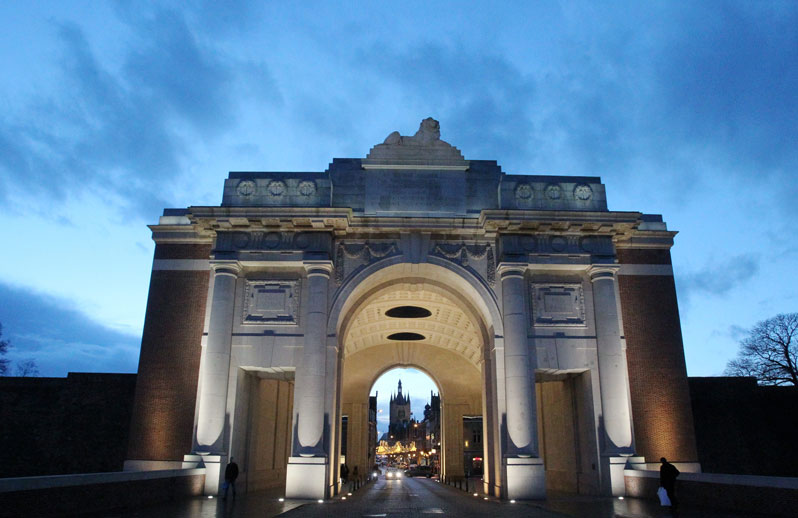
Ypres (Menin Gate) Memorial
The stunning Ypres (Menin Gate) Memorial is visited by hundreds of thousands of people a year, from school groups on battlefield trips to individual history enthusiasts wanting to pay their respects to the fallen.
Straddling a main route out of the city centre, the Menin Gate stands as a symbol of the huge loss of life experienced in the Ypres sector. It commemorates some 54,000 officers and enlisted men from Canada, the UK, Australia, India, and South Africa who died before 16 August 1917 but with no known grave.
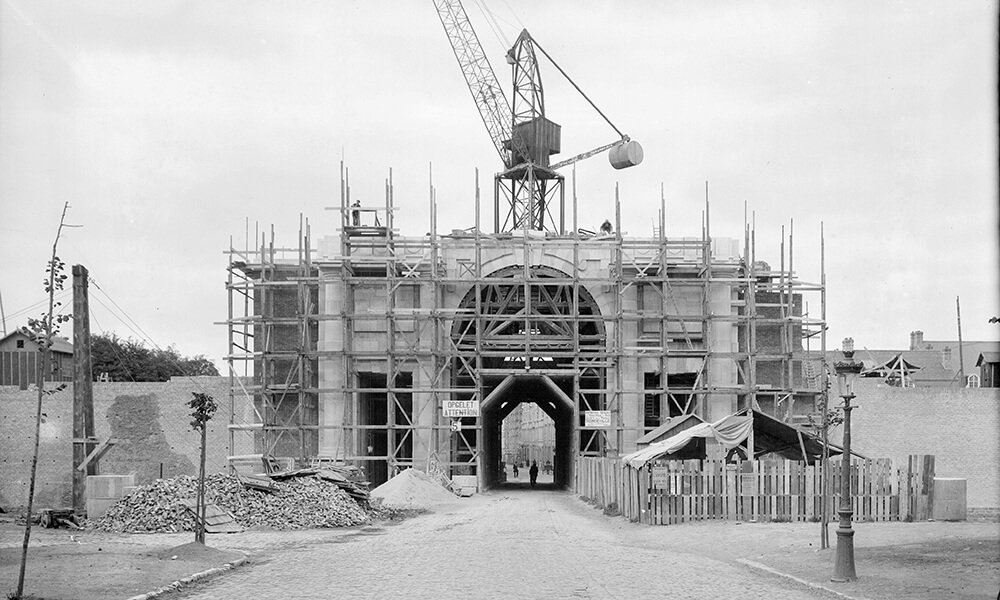
The restoration of the Menin Gate Memorial began in 2023 and is now completed, preserving it for decades to come. Discover more about this remarkable process today.
Read more about the Menin Gate Memorial Restoration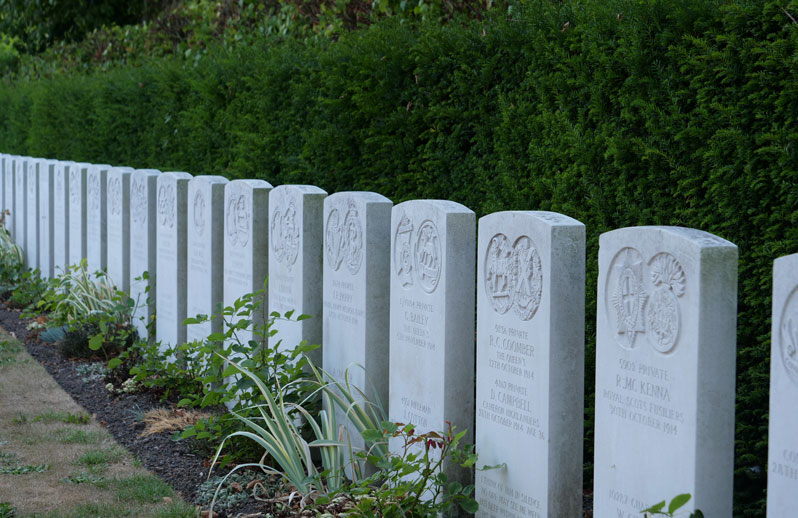
Ypres Town Cemetery & Extension
The establishment of the Ypres Salient was really cemented in October 1914 by which time casualties were beginning to mount.
At this time, there were no established military cemeteries in Ypres. Burials from the early stages of the city’s war were placed in the existing civil cemeteries and churchyards.
For instance, Ypres Town Cemetery holds 120 war graves from October and November 1914.
Ypres Town Cemetery Extension added a further 127 graves shortly after but was significantly expanded after the November 1918 Armistice. Now, just over 600 Commonwealth burials lie within Ypres Town Cemetery Extension.
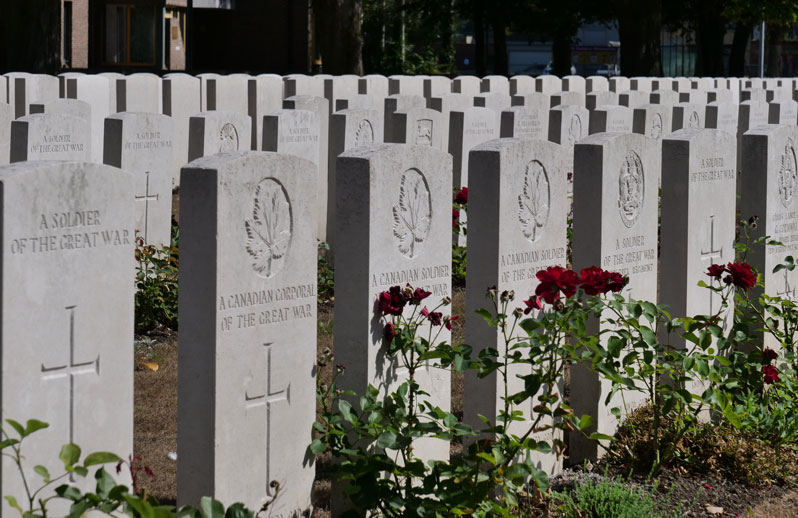
Ypres Reservoir Cemetery
During the Second Battle of Ypres in April 1915, the city sustained a terrible artillery bombardment that left it hammered and scarred. Ypres was essentially turned to rubble but even then certain buildings remained distinguishable.
Near Ypres’ western gate lay the city’s prison and reservoir and water tower. Three cemeteries were built here during wartime with the last first known as “Cemetery North of the Prison” before it was dubbed with its current name.
Ypres Reservoir Cemetery was used by fighting units and ambulances for the remainder of the war. Now, it holds 2,600 or so Commonwealth burials of the First World War. Just under half are unidentified.

White House Cemetery, St. Jean-Les-Ypres
Follow the road from the Grote Markt in the city centre north-east for a short time and you’ll discover White House Cemetery just off the Brugseweg road.
Here lie over 1,100 Commonwealth burials of the First World War alongside eight Second World War burials.
White House Cemetery is an example of concentration. This term means moving burials and war graves from smaller or scattered sites into a singular location.
Many cemeteries within the Ypres Salient are concentration cemeteries. In White House’s case, burials were moved from eight other locations post-Armistice.
Outside of the city limits, there are many CWGC memorials and cemeteries that dot the past battlefields of the salient.
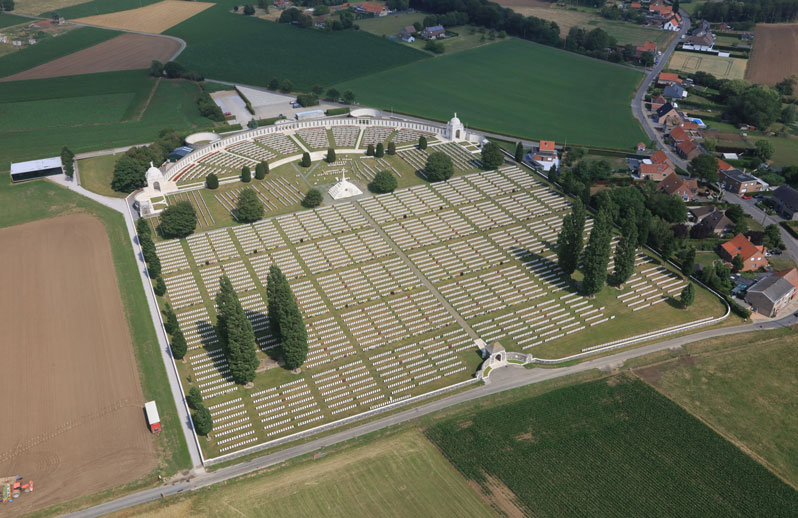
Tyne Cot Cemetery
Tyne Cot Cemetery is the largest Commonwealth War Graves war cemetery in the world and an important stop on many Belgian war graves tours.
Just shy of 12,000 casualties from across the Commonwealth are buried here. Demonstrating the terrible nature of Great War fighting, just 3,600 or so are identified.
A further 35,000 missing casualties with no known grave are commemorated on the Tyne Cot Memorial within the cemetery.
In 1917, British Forces launched the Third Battle of Ypres, known better as Passchendaele. The battle, which raged from July to November, was a terrible slog with over 77,000 Commonwealth soldiers killed. Tyne Cot marks the final resting place for many of these casualties of Passchendaele.
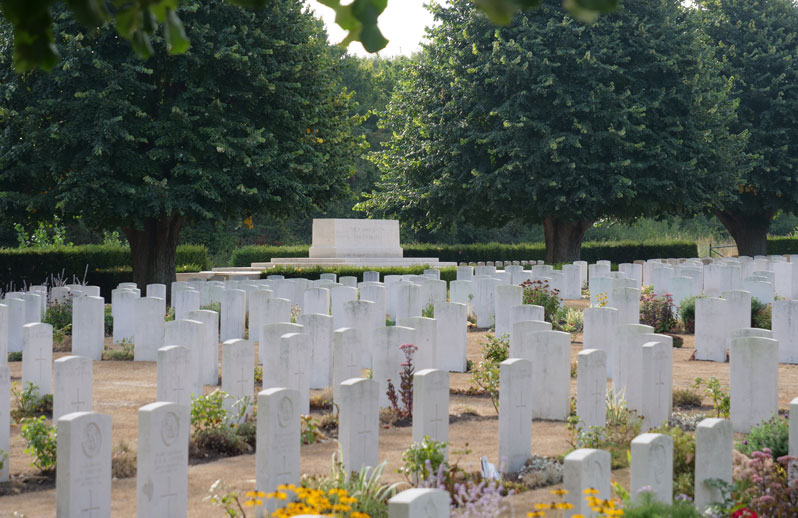
Essex Farm Cemetery
Essex Farm Cemetery sits close to the Yser Canal. Its location formed part of the frontline between April 1915 and August 1917 and was the site of an advanced dressing station, essentially a forward medical post.
In fact, if you visit Essex Farm, you can still see the remains of the concrete operating stations within the cemetery. It was in one of these that Canadian poet John McCrae wrote the now legendary poem In Flanders Fields which is rightly regarded as one of the most influential and important works in the First World War canon.
Reading a cemetery correctly can reveal hidden truths you may otherwise have missed. In the case of Essex Farm Cemetery, some of the headstones are crammed shoulder to shoulder.
That’s because, as an advanced dressing station, the medical staff working there were reacting to and treating casualties coming straight from the frontline, often under fire themselves.
Burials would have been made with urgency and lack of planning in such conditions, hence the cramped conditions at Essex Farm Cemetery.
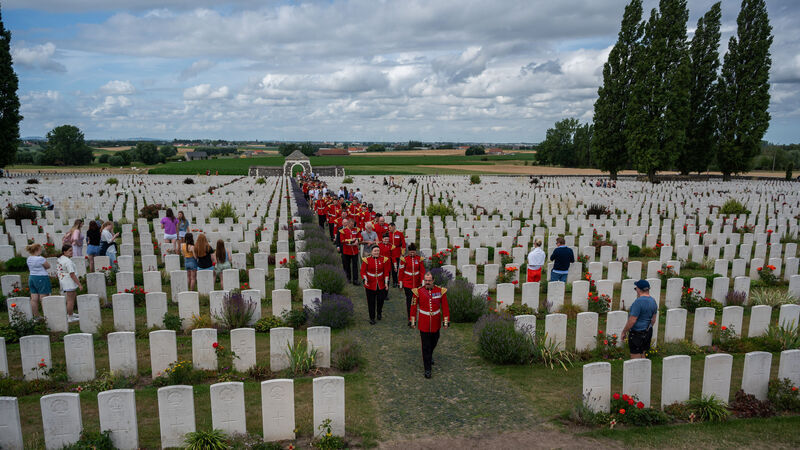
Want more stories like this delivered directly to your inbox? Sign up for our newsletter for regular updates on the work of Commonwealth War Graves, blogs, event news, and more.
Sign UpUse our Find Cemeteries & Memorials tool to search for them and plan your Ieper tour. You will be able to search by country, name, and location – in this case West Flanders – which will reveal all Commonwealth War Graves sites in and around the city.
Visiting Ypres Battlefields
The battle sites near Ypres are many and varied. How you visit them is entirely up to you, but here are some ideas to help you plan perfect Ieper battlefield tours.
Ypres self-guided battlefield tours
Self-guided tours are exactly what they say on the tin: tours you undertake yourself at your own pace without a group or guide.
Luckily, Ypres is a small city with great transport links. It is very easy to get around by car or public transport, but it is advised to drive if possible to take in as many Ypres battle sites as possible on your tour.
Your itinerary and tour plans are also entirely in your hands, but we can push you in the right direction.
With our partner Wesstoer, we have made it possible for you to plan your own Flanders pilgrimage, including visits to our Ypres cemeteries and memorials.
We have set up three suggested tours of West Flanders that explore the region’s landscape and how our cemeteries and memorials interact and intertwine with it.
Ypres tour themes include:
- Landscape – A half-day tour highlighting the scars that still blight the Ypres Salient, some of its last remaining original battlefield features, and how CWGC sites there were shaped by the First World War.
- Passchendaele, the 3rd Ypres Offensive – Passchendaele was one of the most infamous campaigns of the Great War. Experience its story via our sites on this half-day tour.
- Must See – Only got time for one tour of Ieper’s former battlefields? This is the one for you. It covers some of our most iconic Ypres Salient sites, including Tyne Cot and the Menin Gate, that tell the story of the region’s startling wartime experience.
Each tour also comes with free materials that give more information on each site, visitor’s info, and some stories of those commemorated within.
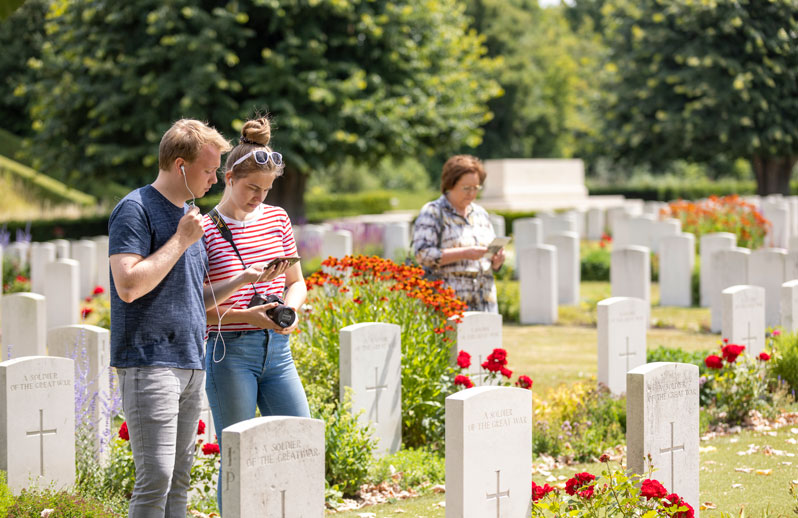
Visit our Wesstoer page to plan your own self-guided tour of our Ypres and West Flanders sites.
Westtoer - Build your own Flanders pilgrimageA Michelin Atlas of Cemeteries and Memorials in Belgium and Northern France is also available to buy from the Commonwealth War Graves Foundation gift shop. Pick one up to help you navigate your way through the region’s former Great War battlefields. All proceeds go to the Commonwealth War Graves Foundation charity.
Don’t forget to visit the CWGC Ieper Information Centre in the heart of the city. Our staff will also be able to help you find our Ypres cemetery and memorials as well as make suggestions on which former battlefields to take in on your self-guided tour.
You can also visit our Tours section to learn more about our prepared war graves tours in Belgium, covering:
- Ieper walking tour
- Tyne Cot Cemetery & memorial tour
- Menin Gate tour
Please note: these tours are not guided.
Private Ypres/Ieper battlefield tours
Numerous operators and travel companies offer Ypres battlefields as part of guided or package tours.
Private tours may also include tours of the Ypres Salient and the Somme in one trip, linking two important regions of the Western Front deeply connected to the Commonwealth’s wartime experience.
While we do not partner with any tour operators specifically, CWGC memorials and cemeteries are often included on WW1 battlefield tour itineraries. Be sure to check with your tour operator of choice to learn more.
Ypres battlefield map
The below map shows the locations of CWGC sites dotting the Ypres battlefields.
As the Ypres Salient was comparatively small but significant, the locations of our cemeteries and memorials provide a good indicator as to where the Ypres battlefield sites lay.
The history of Flanders battlefields
The history of Flanders battlefields is the history of the First World War in which Ypres played an integral part.
It was not Allied troops who entered the city first though. Imperial German Troops first arrived in Ypres on the evening of October 7, 1914. As many as 10,000 Germans descended on the city, with men billeted to sleep in the Cloth Hall, schools, army barracks, shops, and railway stations.
By the next day, however, the German Army retreated from Ypres, taking food, straw, and important supplies. Citizens were left clutching coupons and IOUs for their goods and produce. It seemed highly unlikely they’d ever be paid for the goods taken by the very brief German occupation.
On 13 October, French and British troops entered the city and took up defensive positions to stave off an impending German attack. From the moment the Allies arrived, the historic city of Ypres was embroiled in some of the First World War’s most infamous campaigns.

Image: The devastation of Ypres (© IWM Q 29795)
By the time of the Armistice, Ypres had been shattered. Her picturesque medieval town centre was now a blasted ruin. It would be a long road to recovery, but thankfully, many buildings, such as the inimitable Cloth Hall, stand today in Ieper
But let’s not forget the Second World War. Flanders fields may have stronger links to the Great War in the public imagination, but Ypres was still the site of frantic, desperate fighting during the blitzkrieg of 1940.
The town centre was once again damaged, but not completely levelled as had been the case 30 years earlier.
What battles took place around the Ypres Salient?
Numerous campaigns, skirmishes and major offensives were fought on battle sites near or in Ypres between 1914-1918.

First Battle of Ypres
Fought during the crucial early days of the “Race to the Sea”, the battle ends with the Allies in control of the city but with Imperial German units now dug in positions circling the city. The Ypres Salient is born.
(Image: © IWM Q 57218)
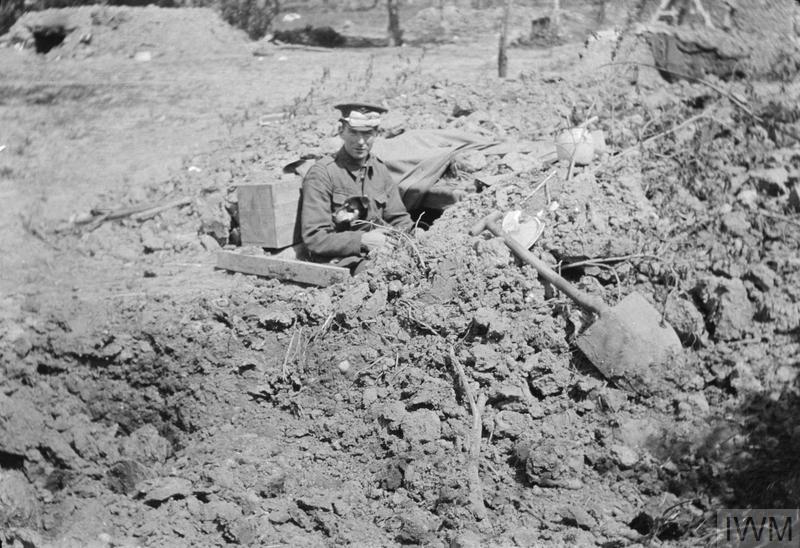
Second Battle of Ypres
The Second Battle of Ypres began on 17 April 1915 with the British attack on Hill 60. Hill 60 overlooked Ypres and whoever controlled it essentially dominated the surrounding landscape. After four days, the British took Hill 60.
Elsewhere, the Imperial German Army attempted to capture Ypres with the war’s first use of gas. The battle lasted until 25 May with the attack halted and Ypres still in Allied control.
(Image: © IWM Q 61600)
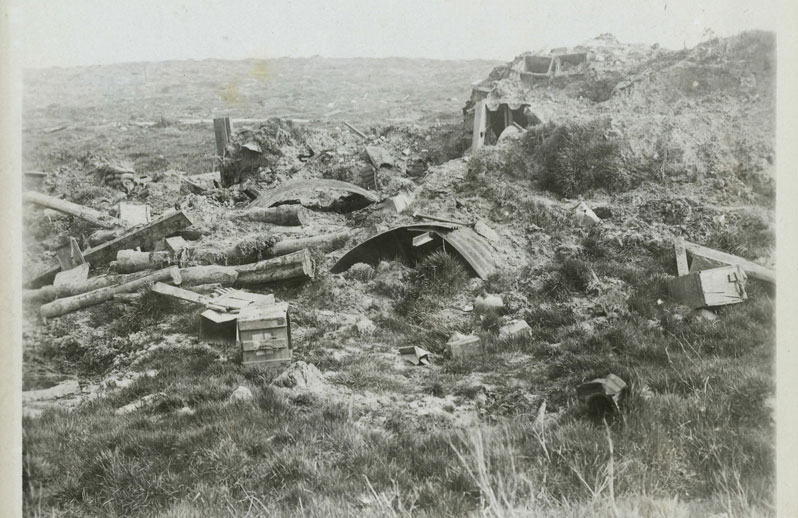
Battle for Mount Sorrel
On 2 June 1916, Imperial German forces attacked positions on Mount Sorrel: more high ground to the southeast of Ypres. Standing in their way were three divisions of the Canadian Corps.
The initial German attack was a success, but by 13 June, the Canadians had driven the German Army back to its starting position. By the end of the two-week battle, 1,000 Canadians had been killed.
(Image: Wikimedia Commons)
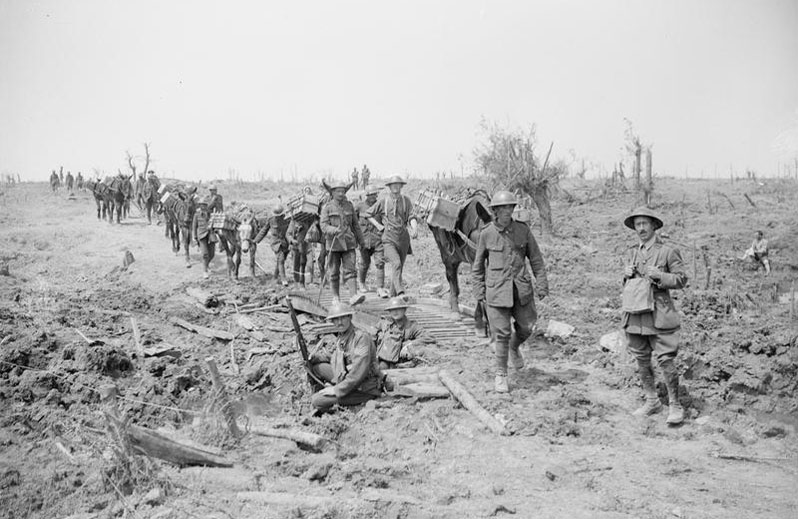
Battle of Messines
On the morning of June 7 1917, 19 huge explosions rocked the German positions on the Messines Ridge. The sound, it is said, could be heard from London.
Across seven days, Australian, New Zealand and British Infantry drove the German Army off Messines Ridge, capturing more high ground and strengthening their position in the southern salient.
(Image: © IWM Q 5488)

Battle of Passchendaele
Also known as the Third Battle of Ypres, Passchendaele was a five-month attack to the north of Ypres undertaken by the British army on 31 July 1917. Torrential summer rains turned Flanders fields into bogs and charnel pits.
The German frontline had been strengthened across Passchendaele Ridge. The combination of dogged resistance and awful terrain and mud meant casualties were horrific.
To make matters worse, all the ground taken during the attack was recaptured in the Spring Offensive of April 1918.
The cost of Passchendaele is estimated to have reached 400,000 losses for both sides between July-November 1917.
(Image: © IWM CO 2252)
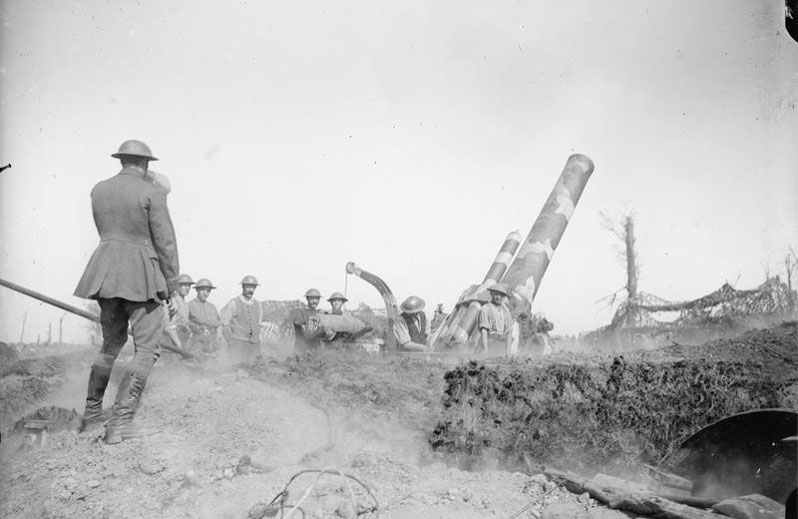
Fourth Battle of Ypres
The Spring Offensive of April 1918 was the Imperial German High Command’s attempt to break the deadlock on the Western Front and win the war. Part of this sweeping attack was “Operation Georgette”: an advance through Flanders on Ypres.
Through a combination of surprise, daring, and new tactics, the German Army was able to recapture all the land lost at Messines and Passchendaele but could not make the final breakthrough to capture Ypres.
The land retaken remained in German hands until September 1918 when it was recaptured during the Hundred Days Offensive at the Fifth Battle of Ypres.
(Image: © IWM Q 7808)
How many battles were fought around Ypres?
The six major battles around Ypres we detailed above included many numerous smaller skirmishes and actions.
Including these, around 30 battles were fought on the Ypres battlefields.
Ypres Battlefields Today
Today, Ieper has been rebuilt but the reminders of its wartime experience can be found everywhere.
The Ypres (Menin Gate) is the most easily identifiable link to the city’s World War past, as are the cemeteries and memorials the CWGC maintains in and around Ieper.
Discover them for yourself with a tour of Ypres’ battlefields. Don’t forget to build your own personal pilgrimage to Flanders Fields or pop into the CWGC Ieper Information Centre to learn more our work, the history of Ypres in wartime, and more ideas on how to plan your perfect war graves tour.

